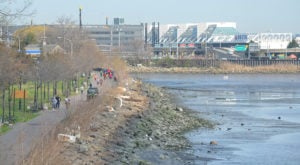FAA ignores transit concerns in LaGuardia AirTrain environmental review
 Since 2015, Port Authority’s proposed LaGuardia AirTrain — for which passengers would have to commute east from Manhattan on the LIRR or 7 train to Willets Point/Citi Field, Queens, before doubling back west to the airport — has received scathing criticism. As the Federal Aviation Administration’s environmental review moves forward and excludes potentially legitimate transit alternatives from its review, public engagement is more critical than ever.
Since 2015, Port Authority’s proposed LaGuardia AirTrain — for which passengers would have to commute east from Manhattan on the LIRR or 7 train to Willets Point/Citi Field, Queens, before doubling back west to the airport — has received scathing criticism. As the Federal Aviation Administration’s environmental review moves forward and excludes potentially legitimate transit alternatives from its review, public engagement is more critical than ever.
As was shown in the November 2019 scoping report, the engaged public does not like the project. Of the 414 comments, only 13 percent supported the project. Civic and block associations voiced homeowners’ concerns that their investment could be impacted by the project and local quality of life could be hindered. The Flushing Chamber of Commerce and local businesses expressed skepticism that they would ever see the touted economic benefits of the project. Riverkeeper and Guardians of Flushing Bay raised concerns about shoreline resiliency, the access to the waterfront and promenade and the visual and direct access to Flushing Bay by surrounding neighborhoods. By far the greatest concern expressed by many, was about increasing ridership overcrowding on the already overcrowded 7 train (some 50 percent of all comments addressed 7 train capacity and infrastructure).
Despite the study’s results, the FAA’s alternatives screening analysis—as presented at the November ‘Community Leaders’ meeting—eliminated every alternative except for Port Authority’s proposed AirTrain and a ‘no action’ alternative, which is required by law. It is difficult to see what role the scoping study played in the analysis, which at first blush reads as a remarkable act of heavy-handed decision making.
As noted in a recent Op-Ed in Streetsblog written by transit expert Benjamin Kabak, “Even though the project enjoys the support of Cuomo and his hand-picked Port Authority leadership, a focused, community-based opposition that could line up behind a transit option with more benefits for the local communities and a more rational price tag could change the conversation.”
Kabak is right, a community-based opposition is essential. Yet thus far, the opposition has been exclusively community-based and the absence of voices from citywide transit equity and environmental advocates has led to legitimate concerns being dismissed as NIMBY-ism. At this point in the ongoing LGA AirTrain ‘conversation’ what we need is community-led opposition that includes independently reviewed transit analysis, we need a diverse coalition of local stakeholders and citywide partners and we need advocates willing to fight for parkland, public transportation and the best use of infrastructure funds in Northern Queens.
Kabak also alludes to the many reasons why this kind of opposition has not yet taken shape. Slated as a priority project by Governor Cuomo, the LGA AirTrain offers, at face value, an energy efficient, mass transit alternative to LaGuardia Airport. However, the proposed project comes with an ever increasing $2 billion dollar price tag, unrealistic transit projections, lack of integration into the existing public transit infrastructure, increased dependence upon the overburdened 7 train, and an inefficient route. If ridership lags behind what the Port Authority projected, then the AirTrain would be a $2 billion piece of massive transportation infrastructure built in a floodplain that takes few cars off the road, adds zero benefit to public transit compared to existing alternatives and obstructs enjoyment of the waterfront.
How can you engage in the process? FAA will hold two public information sessions on Tuesday, January 14th and Wednesday, 15th 2020 in East Elmhurst at LaGuardia Airport Marriott hotel where FAA will give an overview of their alternatives screening analysis. The FAA needs to hear the voices of community experts, environmental advocates and the transit equity community. You or your organization can also reach out to the Sensible Way to LGA Coalition at [email protected] to get involved in our advocacy. We need all eyes on this environmental review process before it becomes yet another top-down, heavy handed project masquerading as community-approved infrastructure.
